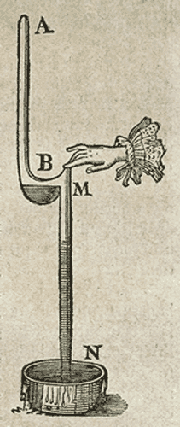|

Variations on
the ordinary Torricellian tube for the experiment of the void within
a void.
Pascal, Traitez de l'equilibre des liqueurs, et de la pesanteur
de la masse de l'air, Paris 1663
|
One of the decisive confirmations
of the influence of atmospheric pressure was given by the so-called
"void within a void" experiment, performed in 1648 in a variety of
ways by Roberval, Adrien
Auzout, Pascal, the members of the Accademia
del Cimento and Robert Boyle, successively.
They discovered, in fact, that if the torricellian experiment was
performed within a vacuum, the mercury was not held up in the tube,
but descended completely into the basin. It was observed, too, that
when air was allowed back in, the mercury went back up the tube.
To confirm Torricelli's experiment, Blaise Pascal thought up a definitive
proof, in 1648. He had a barometer carried to the top of the Puy de
Dôme, in the Massif Central in France, where the level of the column
of mercury fell to a few inches lower than at normal ground level.
Pascal correctly interpreted this variation as a result of the lowering
of air-pressure at altitude.
|

